| 1 | Australia’s longest snake |
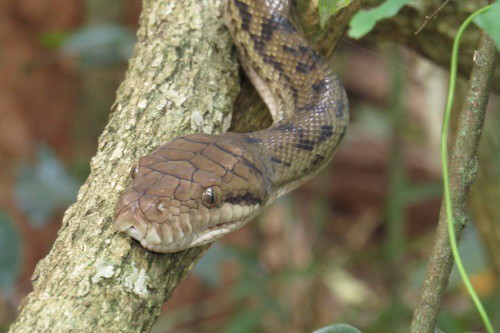
The scrub python (Simalia kinghorni) is a massive constrictor which ranks as the official longest snake in Australia, among 172 species. It’s also the fourth longest snake in the world, behind the reticulated python, green anaconda and African rock python.
Unlike carpet pythons, scrub pythons live well away from humanity, in closed canopy rainforests and regenerating forests. They never appear in Sydney suburbs, and compared to carpet pythons, they live far further north. In Australia, scrub pythons live exclusively in Queensland, particularly in the Cape York peninsular. They range from 1.5-4 metres, with males exceeding females. Even hatchlings average at 70cm long, exceeding the adult length of Australian blind snakes.
Scrub pythons mainly eat mammals, with some birds. Their meals include bush rats, northern brown bandicoots, striped possums, agile wallabies, Bennett’s tree kangaroos, and spectacled flying foxes, a giant bat species. This species also lives in New Guinea, but is the subject of a furious debate. Some believe the two to be united, but some believe the New Guinea colonies to be a separate species called the Amethystine python (Similia amethistina).
| 2 | Wallaby wars |
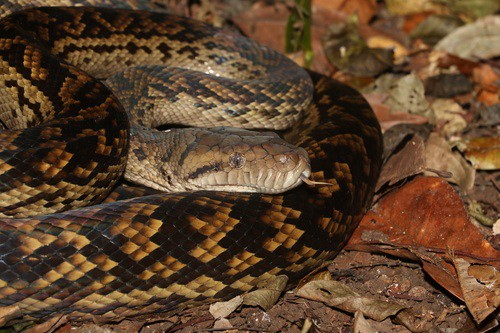
In northwest Australia, olive pythons have been filmed battling freshwater crocodiles in full view of stunned daytrippers. Meanwhile, scrub pythons are the nemesis of wallabies. This eternal duel shot to headlines in December 2016, when a scrub python was found constricting a wallaby on Paradise Palms golf course in Cairns. One by one, golfers were forced to walk past this brutal scene, walking to the next hole wondering whether the snake succeeded.
Eventually, the 4 metre scrub python swallowed the wallaby and retreated slowly to a bushy creek to digest its meal. But the war sometimes takes on a brutaller twist. Scientists came across a 433cm scrub python in Townsville, northeast Queensland in 2001, which had savage wounds on its neck area, so deep and bloody that they exposed its trachea. They found an agile wallaby in its clutches, whose feet were covered in blood, with no wound of its own to explain said blood. The scrub python took over 2 hours to swallow this bulky meal.
Similarly, a 330cm scrub python was spotted eating a Bennett’s tree kangaroo near Cooktown, again with brutal wounds to its neck, as well as old, healed scars in the same area. Scrub pythons have a favourite meal, but marsupials also have a strategy for combatting this giga-constrictor, and it’s fair to assume that they win sometimes, though it hasn’t been recorded yet.
| 3 | Habitat: prefers rainforest |
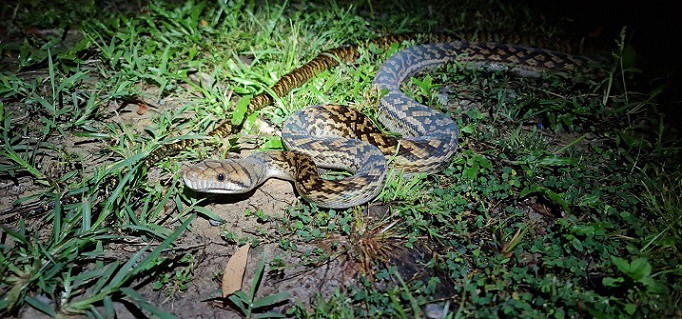
The best scrub python study so far took place in the Atherton Tablelands southwest of Cairns, named because they’re an elevated plateau 700-900 metres above sea level. It’s a zone of rainforest interspersed with more open sclerophyll forest, plus grassland inbetween, sometimes with vegetation up to 1 metre long.
Scientists inserted harmless radiotransmitters into 3 male and 3 female scrub pythons. These weighed just 16-21 grams, and didn’t slow them down, as snakes are especially easy to fit radiotransmitters into, partly because their skin naturally loosens and sheds. The carpet pythons were tracked for 2.5 years, over varying lengths of time. The longest was a male measuring 364cm, and weighing 6.53kg.
Between the snakes, there were several hundred radio transmissions. The results were pretty clear: 432 or 67% of transmissions were from rainforest locations. 94 or 15% were in regrowth areas, former human interference zones in the process of returning to rainforest. Grassland accounted for 10% at 91 sightings, and even then, they clung closely to their forest sanctuaries. At no point in the study did a scrub python move than 30 metres beyond the rainforest or forest edge.
| 4 | Towers high above the ground |
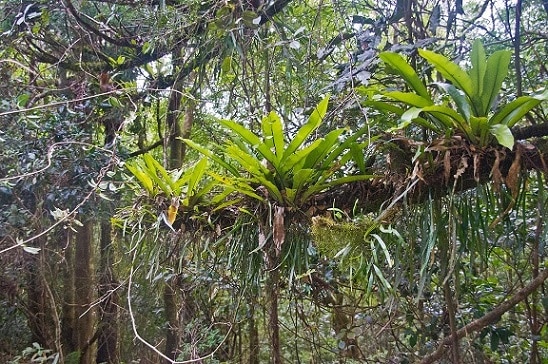
One feature of Queensland rainforests are the many epiphytes found in them. Epiphytes are plants that live on fellow plants, but don’t drain resources from them, meaning that they aren’t parasites. They simply rely on the physical structure of trees, and the basket fern, for example, is a green epiphyte found high above ground in Queensland rainforest trees, with a diameter of 1 metre.
Queensland rainforests can be chock full of these epiphytes, representing nearly 50% of overall vegetation. According to the study, scrub pythons chose these epiphytes above any other spot, particularly basket ferns. Across all habitats, nearly 50% of sightings were of them sitting comfortable in these high ferns, like a comfortable cushion, or a dog basket.
Many towered above the ground. The average height was 21.7 metres, while the range was 17 to 40 metres above the rainforest floor. Each forest could have dozens of these mini platforms clinging to tall trees at varying heights, each home to a scrub python, like something from Lothlorien in Lord of the Rings. They particularly favoured them in winter, possibly to bask in the sunlight away from the shaded forest floor.
| 5 | Loyal to certain trees |
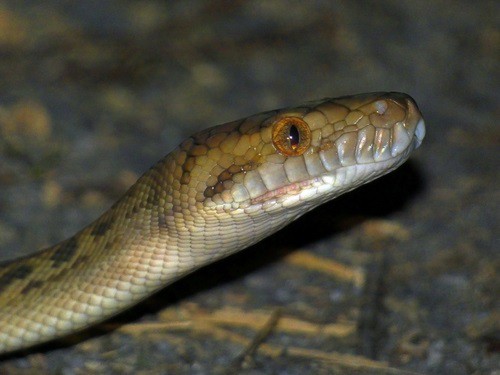
In line with their tree-dwelling nature, scrub pythons have a much thinner body than the carpet python in Sydney further south, which mainly sticks to the ground. Swedish explorer Carl Lumholtz wrote about how aboriginals climbed 50-60 yards into a basket fern to retrieve the carpet pythons resting in them, drawing sketches of this epic act. Baked scrub python was considered a delicacy by the Aboriginals. Not surprisingly, scrub pythons are excellent climbers, grinding upwards slowly and deliberately rather than dashing up thin branches.
The study also found that scrub pythons regularly return to the same tree. One carpet python remained in the same epiphyte for 66 days, and another returned to the same epiphyte three times between July 18th 2004 and June 27th 2006. One scrub python used 5 different epiphytes on multiple occasions. These giant constrictors may have hidden intelligence.
Also, just 8% of sightings were in sclerophyll forests, which is the main habitat of green tree pythons, another Queensland native. Both like rainforests, but apparently have subtly different habitats which prevent competition.
| 6 | Rumours of giga-pythons |
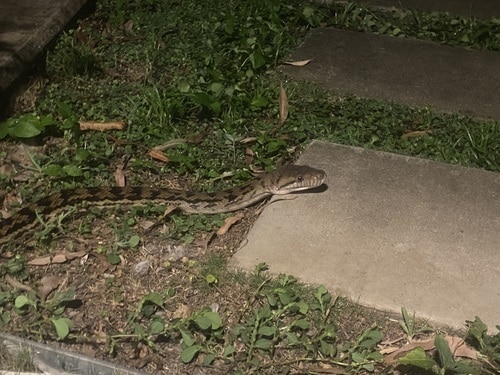
Like any giant snake, there’s murky rumours and heresay all over the debate as to the alltime scrub python record. 8.5 metres has long been floating around, first mentioned by a Mr Warrel in 1954, found in Greenhill, Cairns, and discovered by a Louis Robichaux. In 1958, Warrel mentioned the same python, but gave its length at 7.8 metres. By 1963, Warrel was back to the original estimate of 8.5 metres.
In retrospect, it’s believed that this was just a skin. Snake skins can easily be 3 metres longer than the animals they came from. It’s inevitable that they twist and deform as they’re sloughed off, and lengthen when there’s no meat holding them together. There’s still a slight chance that this giga python was real, as some theorised that 780cm was for the full carcass, and 850cm for the skin.
Another candidate was a scrub python discovered in Barron Falls, northern Queensland in 1954, listed as 722.5cm. But more problems showed up. The scrub python was already dead when discovered, hanging for 2 days to rot over a pole at an empty tent site. Before measurement, the python was dragged over rugged, rocky terrain, distorting its length. This record was dismissed too.
| 7 | The longest scrub python recorded |
It’s now March 2024, and the alltime scrub python record still dates back to 1999, the longest officially validated by scientists anyway, as it’s likely that aboriginals have seen even longer ones. The site was Veiver’s Road, Palm Cove, Queensland. The determined scrub python was attempting to infiltrate the house via the verandah rafters.
The owners requested help, and the snake was removed, but nobody could have expected how large this snake was. The scientists used expert manouvres to induce a state of relaxation in the python. They measured the infiltrator snake from head to tail, and found a length of 565.1cm, followed by a weight of 24kg. Its head width was 7cm, and its girth was 36.0cm at the mid-section.
By contrast, the longest confirmed carpet python measured 4.2 metres. The longest confirmed olive python measured over 4 metres. This scrub python was actually a female, whereas males are normally longer. The male scrub python record dates back to 2001, and measured 532.5cm. This was another home infiltrator, this time in Kuranda, northeast Queensland.
| 8 | Scrub python island |
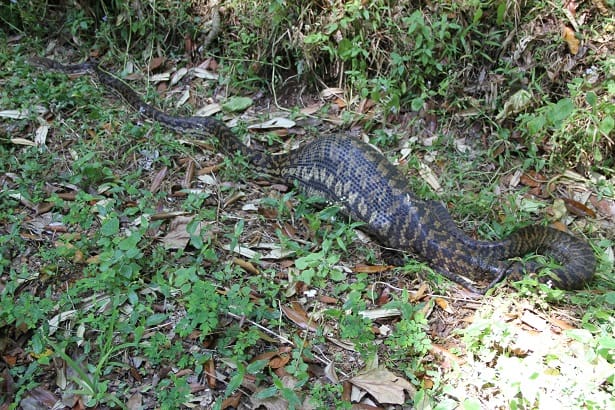
Scrub pythons might lack venom, but they have one thing the cottonmouth doesn’t: their own island. This is Milman Islet, a 22.7 hectare paradise found in the Great Barrier Reef, off the coast of Cape York peninsular. Excluding the pristine sandy beaches, nearly the entire island is forested, specifically with grey corkwood and Australian almond trees. The island is a hub for nesting birds and endangered hawksbill sea turtles, and entry to the island is strictly forbidden without permission. Those who disobey are subject to on the spot fines.
The main landing point lies in the island’s northwest, and this is impassable during low tide. Somehow, in the distant past, scrub pythons reached this island, perhaps by washing through the ocean, propelled by a ferocious hurricane. Their forest habitat is plentiful, and they’re thought to snatch birds’ eggs from nests.
Similarly to many island snakes, the scrub pythons here are shorter than the mainland, rarely exceeding 2.5 metres. Their preferred mammals are few and far between, with meals including crabs instead. Scientists aren’t sure whether they’re now genetically smaller, or whether the Milman Islet scrub pythons would balloon to their normal size if fed mammals again.
| 9 | Mainly nocturnal |
Another large study took place at the northern tip of Queensland’s Cape York peninsular. It was another epic quest, featuring 27 snakes tracked for a mean of 426 days, recording a total of 1406 transmissions.
Again, closed forest was easily the favourite habitat, and the scrub pythons were found there in much high proportion to its availability in the study zone. Rainforest was the only habitat where all 27 snakes were observed.
The scrub pythons were mainly nocturnal, and males had larger home ranges than females. The scrub pythons were relatively tolerant, as the home ranges of individuals regularly overlapped with each other. That said, this a solitary snake; they rarely rest in the same basket ferns together.
The scrub pythons were energetic by python standards, as they had a daily displacement of 9.8 metres. This was just the displacement; the actual movement was far higher, reaching 107 metres daily, as they often went back and forth within one area. The record movement was a scrub python which moved 364 metres in one day. The scrub pythons moved most at dusk, 18:00-20:00, and retreated to their dens at 06:00-08:00.
| 10 | Covered in scars |
Scrub pythons can be highly tactical hunters. In northeast Queensland, scientists have observed large numbers congregating beneath trees containing starling roosts. The patient pythons simply wait below the tree while nestlings occasionally plummet to the ground, from the thriving bird community above. These congregations are rare for scrub pythons.
Other gatherings include male-female couplings, and savage wrestling matches between males. Scrub pythons are often covered in scars, inflicted by a mixture of wallabies fighting back and rival males biting savagely. The goal of wrestling is to win female affections, and it’s usually, though not always the largest male that succeeds.
Many wrestling snakes worldwide never bite each other while in combat, including California kingsnakes, but scrub pythons break this code. A study from Tully River Gorge, Queensland found that larger males had more success with females, yet their bodies featured more scars. This gorge was a hotspot for scrub pythons, a tropical forest in a river valley receiving 3721mm of rainfall annually.
